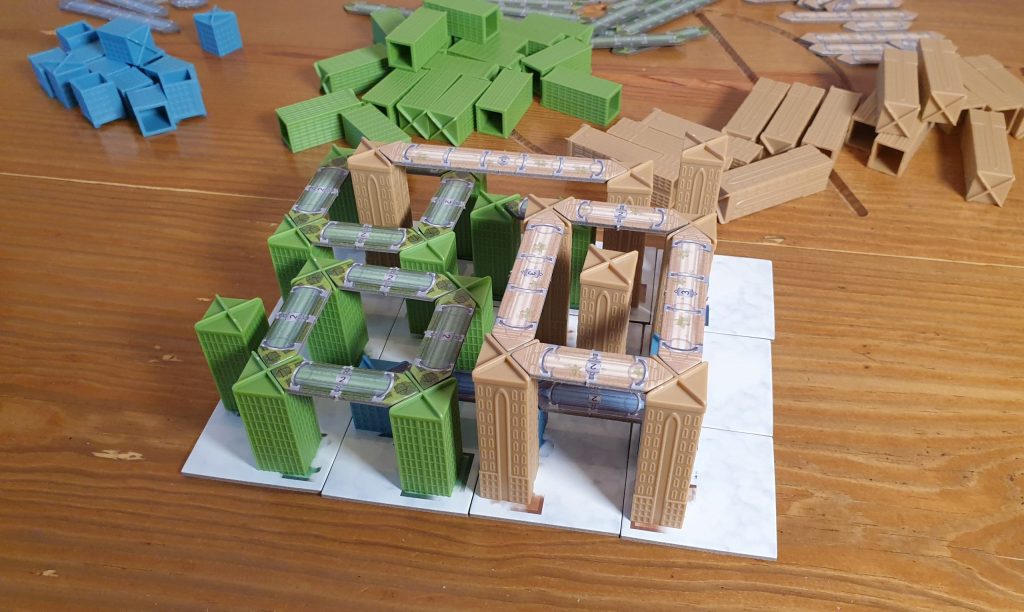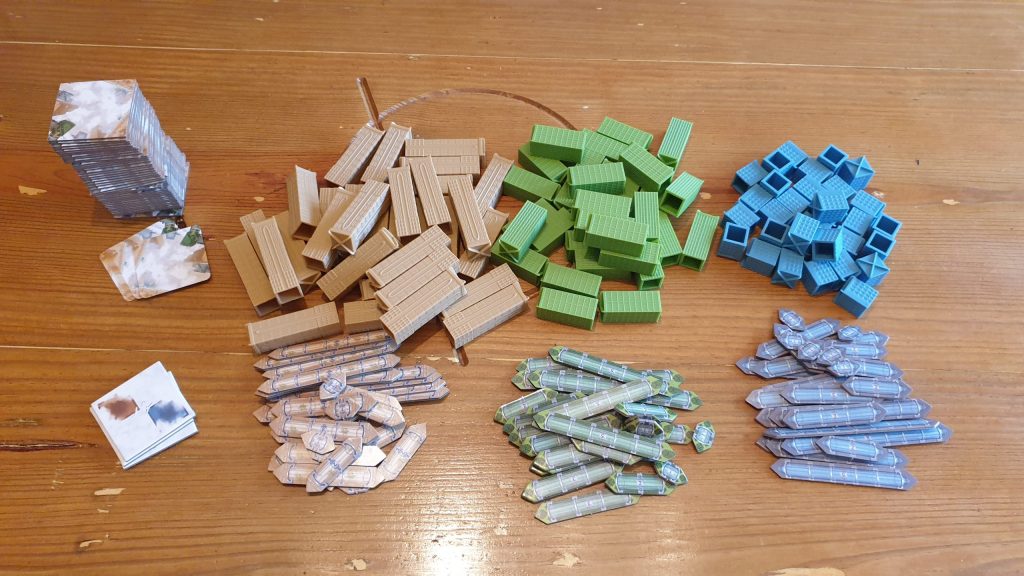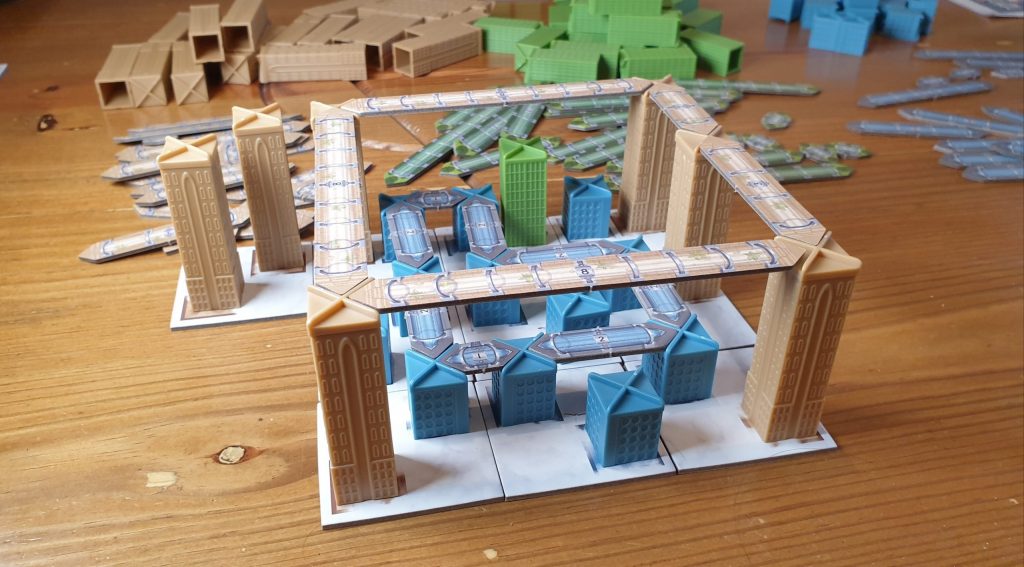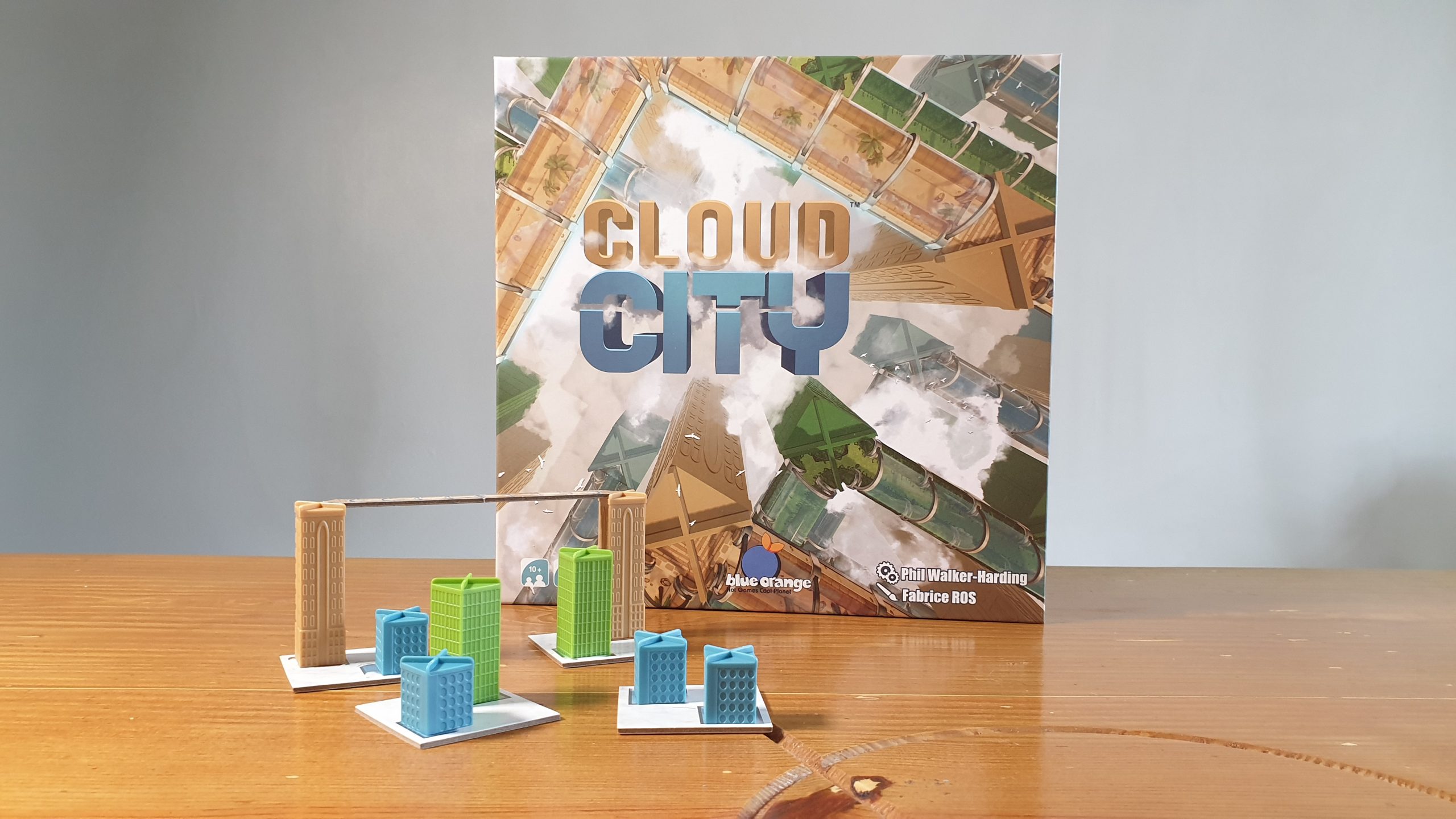Cloud City is the brand new tile placement board game from designer Phil Walker-Harding. Published by Blue Orange, the game sees 2 – 4 players become city planners for the Cloud City. Building out the city, skyscrapers can be linked via walkways, votes will be gained and only one architect will be chosen. Taking around 30 minutes to play, the game is a family weight experience – though there is an optional advanced variant. However, will players want to keep returning to the clouds? Let’s find out!
Each player places their starting tile in front of them and claims the depicted buildings, as well as a hand of three cloud tiles. Buildings come in three heights small, medium and large (blue river, green forest and beige sand respectively). Therefore, if the tile depicted two blue squares the player would claim two of the small blue river buildings and place them onto the tiles – on top of the squares. At this point during set up players would choose a Special Request card to put in play – if playing the advanced variant. The final part of setup is to shuffle the remaining cloud tiles and make a market of three face up tiles.
With the aim of gaining the most votes (victory points) from constructed walkways, players will be looking to play tiles to place buildings that they can link together. Each turn is made up of 3 mandatory actions and one optional one. Confined to a 3 x 3 grid (4 x 3 for 2 – 3 players) players must play one of their three cloud tiles to their city. Then, the player must take the buildings shown and place them on the tile – just like with the starting tile.

At this point players can, but do not have to, link buildings of the same height. Following a few rules, such as no linking diagonally and only two links per building, a variety of different walkway lengths can be utilized. Regardless of the building height the longer the walkway the more votes it scores – with the shortest scoring 1 vote up to the maximum length that scores 8. Before the next player goes the player must take a tile from the market or one off the top of the pile, filling their hand back up to three tiles. The game continues until the players have all built their 3 x 3 city grid. Scoring is as simple as counting the vote numbers on the walkways in your city, with the winner the player with the most votes! In the case of a tie the winner is whomever has the most votes from river walkways, followed by forest and then sand.
Visually, Cloud City is remarkably close to the recent expansion for Barenpark, one of Phil Walker Harding’s other released games, which included monorails. Just like the walkways in Cloud City, the monorails towered above the tiles of Barenpark. Therefore the look of the two is somewhat similar. While there was a bit of a spatial puzzle in Barenpark, points weren’t scored based on length, neither were there differing heights to contend with. These two aspects make the game play rather differently, with players being able to use a variety of walkway lengths, as long as there are pieces left in the supply.
Helping Cloud City further itself from the monorail Barenpark expansion are the Special Request objectives. With 10 of these objective cards included, the rulebook suggests using one or more of these when up to speed with playing the game. Without these Cloud City is firmly in the family game category, to the extent that when playing with gamers you can easily include 2 in your first game. The objectives include scoring points for creating full loops of walkways, through to losing points for crossed walkways. These make each game feel unique. In one game you may choose to build differently for those bonus points and in another it is something to avoid to not lose votes. As gamers will probably use at least 2 a game including more would have been a nice touch. Still, enough are included to play multiple times before seeing the same ones pop up.

Cloud City without the special requests is a bit simple, and there is a general consensus that some ways are easier to score than others. Because of the way any building of any height can interrupt a potential blue walkway it seems much harder to construct an 8 vote river walkway than an 8 vote sand walkway. Towering over the blue and green buildings only the positioning of the sand buildings matters, yet the votes earnt based on length are the same. The consistency helps the game be easier to score up and learn, so it is designed to help the target audience of families. A few extra points for the longest blue/green walkways could have made them more appealing to go for though.
From looking at the rather plain looking cloud tiles the game doesn’t seem like it’ll be an eye-catching one. Aside from the starting tiles which feature some birds these are incredibly boring. Any little details such as other birds or even an airship or two would have made them more interesting. Once built up though with the plastic skyscrapers and the walkways balanced between them, with the walkways criss crossing, then suddenly players cannot help swooping in and looking from all angles. Again, a few details to make the walkways more interesting and different wouldn’t have gone amiss but they aren’t necessary.
To knock one concern on the head… even after a few knocks to the table none of the walkways collapse. When testing a few of the buildings shifted a bit but thankfully the walkways aren’t balanced on a millimeter of the building, their design allows them to sit between buildings comfortably. Even when putting new walkways onto the structures, potentially above some and below others, there hasn’t been that much accidental knocking. This isn’t to say that at times slotting a long walkway underneath others isn’t a tad fiddly. Nevertheless, importantly, it doesn’t make the game hard to play.

Cloud City is another solid family game from Phil Walker-Harding. Turns are fast, though there is always a choice to make. The city builds up in front of you and as the game goes on it gets more and more impressive to look at – especially with the 4 x 3 grids for 2 – 3 players. The special request objective cards are almost a must for gamers. With 2 or 3 of these in play there is more to think about and new ways to score each game – helping the experience stay fresh. Overall, whether it is a game to get players into the hobby or for a casual game night Cloud City is an entertaining title to play!
(Editor’s Note: Cloud City was provided to us by Asmodee for the review. The game is currently available from local board game stores! Find your local store here.)

